"Terceira Metade": Conjugating (Subverting?) the Glocal from Benin: Hazoumé, Zinkpé, Quenum
From Africa, and more specifically from Benin, Dominique Zinkpé1, Gérard Quenum2 and Romuald Hazoumé 3 elaborate their poetics, introducing themselves into the global art and culture systems that subsume them, in processes characteristic of contemporaneity 4.
Hazoumé, Quenum, and Zinkpé conjugate the glocal, for their works circulate both through the local sphere in which they operate and within the global culture to which they are both attentive and directed. At first glance, the syntagms (objects and figures) and the semantics (themes, content) are local, while the syntax is representative of present-day artistic practices, given that the artists adopt many currently reigning formal and conceptual methods. In effect, Hazoumé, Quenem, and Zinkpé produce works in both traditional and new media. And they speak of Beninese themes, African themes.
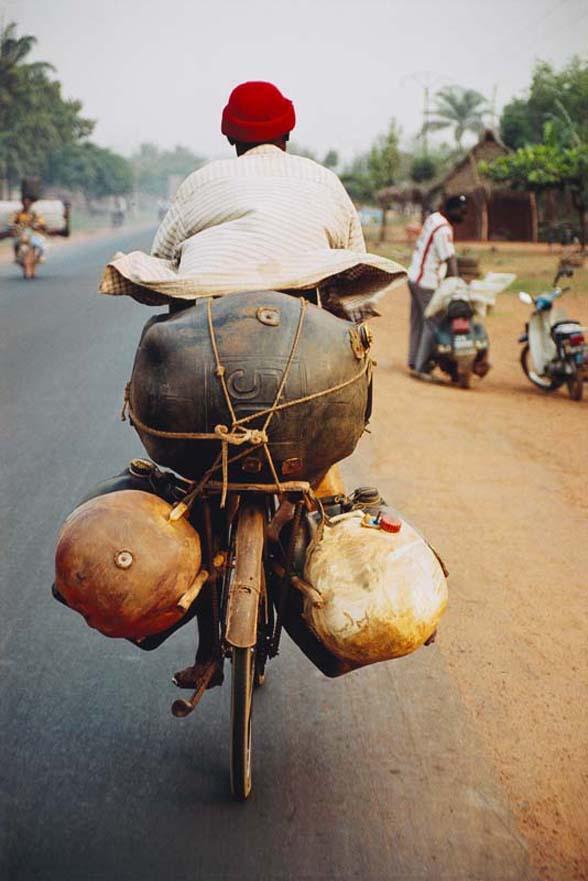 Romuald Hazoumé, 'Avion de Terre' 2004, Fotografia em papel ed. 1/6 | 120 x 80 cm, Col: Queensland Art Gallery, créditos Romuald Hazoume 2004 /ADAGP. Licensed by Viscopy, Sydney, 2010
Romuald Hazoumé, 'Avion de Terre' 2004, Fotografia em papel ed. 1/6 | 120 x 80 cm, Col: Queensland Art Gallery, créditos Romuald Hazoume 2004 /ADAGP. Licensed by Viscopy, Sydney, 2010
Nonetheless, the fact of their concentration in stereotypes of Africa firmly entrenched in the Occidental imaginary—masks, sculpture, handicrafts, religious symbolism, the vitality of the human body—permits the viewer a recognition of the distinctive ways in which each addresses the expectations of an artistic and cultural system for which they conjugate, with an accent, the Esperanto of modern international art.
Hazoumé feeds the persistent demand for African masks. Yet, to do so, he seizes upon what was originally non-artistic material, commonplace throughout the world: jugs for carting liquids; in this case, the jugs are acquired from the ubiquitous motorcyclists in Benin who participate in the illegal fuel trade. In a similar way, Zinkpé addresses the constant pleas for African sculptures of a spiritual character by posing series of prefabricated statues acquired from the handicrafts markets where they are sold for use in religious rituals pertaining to the cult of twins (hoho in Fon, ibéji in Yoruba)—formerly feared, but later interpreted as omens of wealth and happiness. Quenem answers the fad for African fetish figures with his linear assemblages of irregular scraps of cast-off wood, second-hand dolls of Western manufacture, donated to African children by aid organizations and then thrown out again, their skin darkened by the artist, as well as other waste material—industrial, artisanal, or organic—he finds lying about.
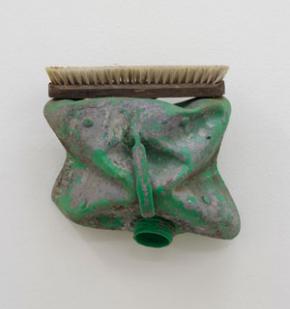 Romuald Hazoumé, 'Cher Maître', 2001
Romuald Hazoumé, 'Cher Maître', 2001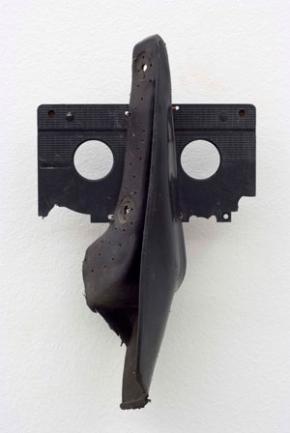 Romuald Hazoumé, 'Vidéo', 1999
Romuald Hazoumé, 'Vidéo', 1999
Extrapolating their critique to the demands placed upon Africa by the art market and the culture industry, these artists show themselves immune to, if not ignorant of, the self-absorption prevalent in contemporary art. They do not cease to question the processes according to which of African artists in general, and of those from Benin in specific, at once infiltrate and are assimilated by the systems of art and culture. Still, these pieces’ scope is not limited to a more or less ironic critical stance, nor to the enthusiasm for sculptures imbued with exotic symbolism, formal primitivism, and ancestral vitality, which has invigorated occidental culture persistently since the early appropriations of the modernists. They are governed by other questions.
Exemplary of the manipulation of occidental elements in the expression of Beninese lifeways are the “Taxis-Zinkpé” installations with their overburdened vehicles, Hazoumé’s assemblages and multimedia installations, compiled, in the same way, from automobiles, gas jugs, and other detritus, the piece “Taxi-Brousse” and another canvas, like the former piece, from 2009, in which Quenum represents yellow Volkswagen Beetles broken down or flooded with passengers. In these works, one can glimpse the quintessentially African custom of adopting private vehicles as collective means of transport and hence as mobile spaces of intense social intercourse. The interest taken by these artists in collective taxis is not mere coincidence, but relates to problematic aspects of African society.
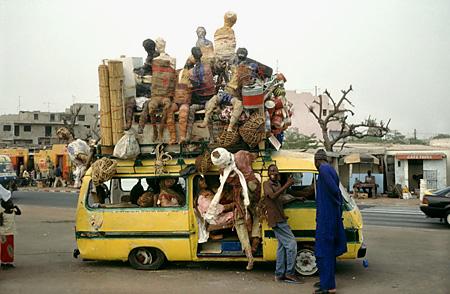 Dominique Zinkpè, Taxis Zinkpè, Dakar, 2002 Foto. Christian Hanussek 2002
Dominique Zinkpè, Taxis Zinkpè, Dakar, 2002 Foto. Christian Hanussek 2002
With his cars and his jugs, used in the illegal transport of petroleum derivatives, Hazoumé speaks of the problems that affect the Beninese people: the traffic in fuels, which structures the local economy and galvanizes Benin’s social life; the slave trade, marks of the influence of which persist in societies on both sides of the Atlantic; passes in football or the explorations of musicians, with their disparities which allude to asymmetries in times past. Equally caustic is the tone of Zinkpé’s “Malgré tout,” an installation consisting of a body laid out in a hospital bed fed by IV’s marked with the names and acronyms of the various international organizations at whose hands Africa suffers as a result of a misguided or even malicious samaritanism which, by maintaining Africa exhausted and in a state of need, insures the continent’s continued dependence on external aid. The domination entailed by this international samaritanism is suggested in one of Quenum’s recent paintings as well, in which a profusion of semicircles in the upper half—domes and helmets bearing the letters UN—hover over the tangle of heads and people in the lower.
Furthermore, there is an obvious relation both between Quenum’s blackened dolls and Zinké’s twins and the daily suffering of African children and Hazoumé’s jug-masks and the fuel-carters on their motorbikes—weak links in an economic chain devoted to the enrichment of outsiders.
But these works are far more than a distillation of social critique. They also take up the mythic traditions of the region, in Zinkpé’s twins, symbolizing prosperity; in the renovation of the bocio—representations of kinfolk, ancestors, and spirits—represented in the totems made by Quenum from wood scraps, castoff dolls, and detritus; in Hazoumé’s canvasses, with their evocations of Ifa, among other symbolic systems from Africa’s many native religions, and the emblems of spiritual initiation in his appropriated jugs.
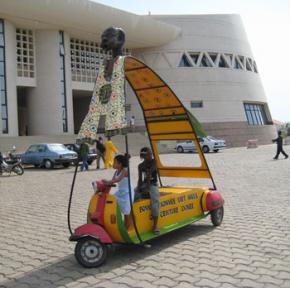 Dominique Zinkpè participou no Festival International de teatro do Benin, com a intervenção 'awobobo Zinkpè', quatro viaturas gigantes que se passearam na cidade de Cotonou.
Dominique Zinkpè participou no Festival International de teatro do Benin, com a intervenção 'awobobo Zinkpè', quatro viaturas gigantes que se passearam na cidade de Cotonou.
These composition, with its lack of distinction among more and less traditional media, is typical of art today: drawing, painting, and sculpture vie with photography, collage, installation, assemblage, multimedia, and readymade. It is important, however, to stress that the transformation of these techniques is tied to longstanding local—particularly religious—cultural traditions in which new beings are given life through the combination of heterogeneous elements. The presence of words of varied linguistic origin in the titles of these artists’ work—French, Yoruba, Fon, English—is another indication of the diverse references they manipulate and the hybrid nature of their production.
Just as these artists, in their treatment of language—artistic or no—transition between the global and the local, so, in their approach to cultural questions, they go far beyond their place of origin and the regions where they operate.
The Gerard Quenum’s canvas with the yellow Volkswagen could have been produced in many parts of the world: first because the Beetle is a world presence, Germany from the second half of the 1940’s when it was produced in Germany until 2003, when the last model rolled off the assembly line in Mexico—and this without mentioning their continuous worldwide diffusion; second for the method of the painting’s execution. To begin with, it is a canvas, a pictorial medium developed in Europe, but one that alludes both to omnipresent urban graffiti and to artistic modernism which, from its base in Europe, spread to become a universal idiom. From its frontal perspective, we are shown five human heads inside the car. Their somewhat schematic depiction could lead one to think them barely human. A moment is described: persons traveling in a Beetle. Though it is a scene of local customs—the collective use of taxis—it thematizes aspects of global life in the second half of the twentieth century.
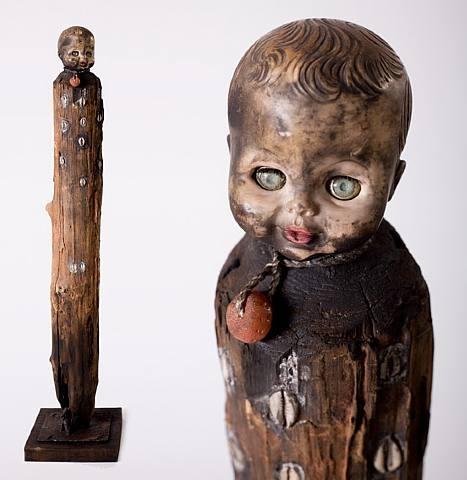 G. Quenun, 'Vodounsi (Priestess)', 2006
G. Quenun, 'Vodounsi (Priestess)', 2006
It is not difficult to see how, in these works and others, Quenum, Hazoumé, and Zinkpé treat micro- and macropolitics in their exploration of the links binding the economy, the culture industry, and the image in the context of contemporaneity. The questions they respond to artistically cannot be dissociated from political ones of a local, regional, and global reach—the use of available natural, human, and financial resources, or consumerism in the post-industrial order—nor from cultural practices of a universal character: religion, memory, history, gender relations, the sartorial and the ludic.
More than a mere mastery of Occidental idioms, this appropriation of techniques and objects from universal culture, this invention of elements with which to affirm themselves as creators and broaden the field of possibilities in art, inaugurate a wide-ranging poetics.
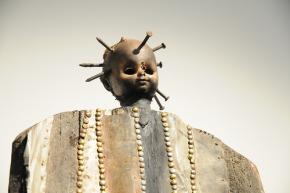 Gérard Quenu, 'Benin está vivo ainda lá Ancestralidade e Contemporaneidade', Museu Afro Brasil.
Gérard Quenu, 'Benin está vivo ainda lá Ancestralidade e Contemporaneidade', Museu Afro Brasil.
The titles of Hazoumé’s masks of jugs, hair, and fabric, the titles of which refer back to the religious markings, female hairstyles, clothing, jewelry, and other signs derived from or associated with the body, initiate a new approach to subjectivity. Beyond the implications of the human that arise from “Taxis-Zinkpé,” with their exuberant blend of vehicles, entities, and objects, the linearity and color in Zinkpé’s paintings and drawings, while an appropriation of foreign techniques and idioms, speak of human beings, their relations and their memories, their ideas and their feelings. And beyond the bocio, with their mystic and nostalgic evocativeness, Quenum’s paintings express universal human passions and feelings, as epitomized in the pulsing red heart in one of his recent canvases.
It is this universalism that separates these artists’ work from mere pamphleteering subordinate to politics, and raises it to the level of a political gesture committed with, in, and for art.
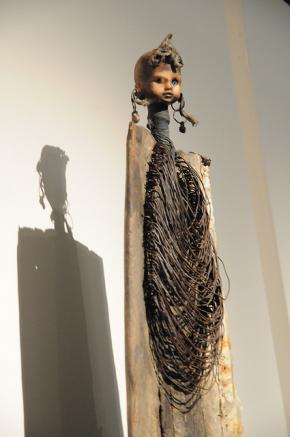 Gérard Quenu, 'Benin está vivo ainda lá Ancestralidade e Contemporaneidade', Museu Afro Brasil.
Gérard Quenu, 'Benin está vivo ainda lá Ancestralidade e Contemporaneidade', Museu Afro Brasil.
Hazoumé, Quenum, and Zinkpé, in their fusion of the syntagmatic, the semantic, and the syntactical, make plain their subversion (if not their abandonment) of the equation that incentivizes, asks, or demands the conjugation of the glocal, with infiltrations that dissolve local and Western expectations of what a contemporary art with roots in Benin, in Africa, should look like. In this way, they work to wear away at those international processes of institutionalization in which they participate and to which they are subject. All of which implies, beyond other whatever other ends for art might be conceived from the African perspective, a revision of art criticism and of the historiography of art, as much with reference to Africa as to the rest of the world, from before modernity to the present day.
Terceira Metade (Third Half) is the first edition of a project from the Rio de Janeiro Museum of Modern Art (MAM) dedicated to think about the Atlantic Ocean space, specially about the Brazil/Africa/Europe triangulation. Curators: Marta Mestre and Luiz Camillo Osorio
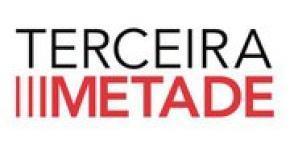
- 1. About Dominique Zinkpé: ZINKPÉ, Dominique. Táxis Zinkpé. Cotonou: AYIZO, (s.d.).
- 2. About Gérard Quenum: QUENUM, Gerard. Gérard Quenum. London: October Gallery, 2009.
- 3. About Romuald Hazoumé: HAZOUMÉ, Romuald. ‘Ensaio’. Concinnitas – Revista do Instituto de Artes da UERJ, Rio de Janeiro, UERJ, ano 11, v. 1, n. 16, jul. 2010, p. 57-72; –. Made in Porto-Novo. London: October Gallery, 2009; –. La Bouche du Roi. Paris: Musée du Quai Branly; Flammarion, 2006; –. Romuald Hazoumé. Cotonou: Fondation Zinsou, 2005.
- 4. The realization of this text was supported by the Ministry of Foreign Affairs, Ambassador Arnaldo Caiche D’Oliveira, Milton Guran and André Jolly, whom the author thanks.